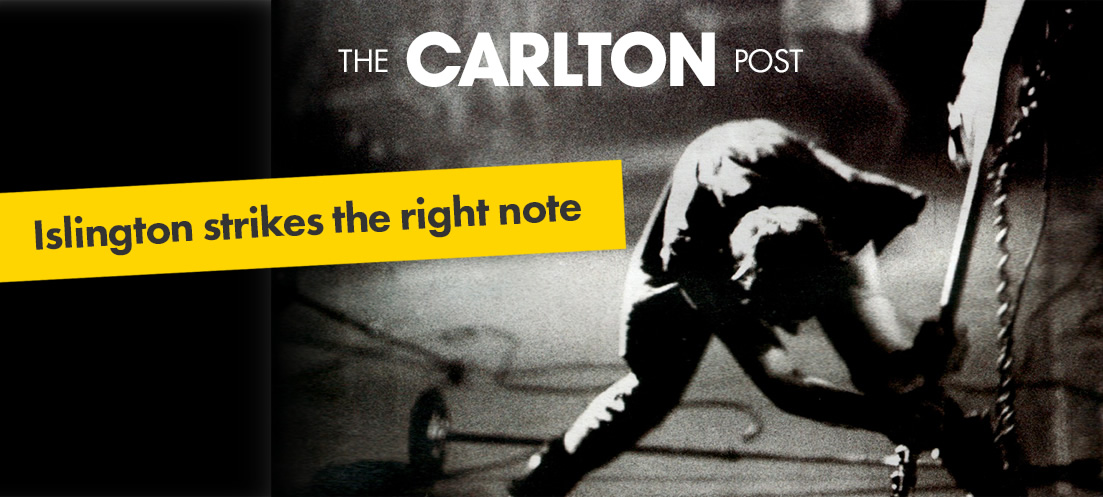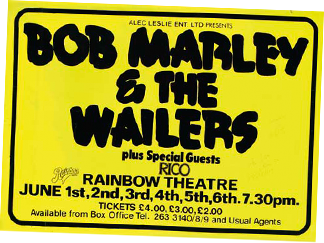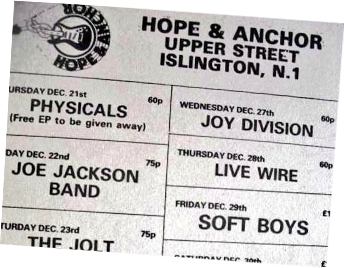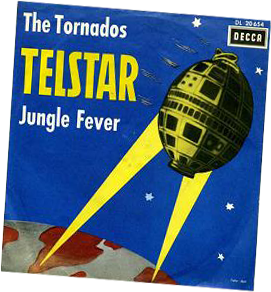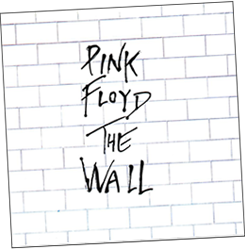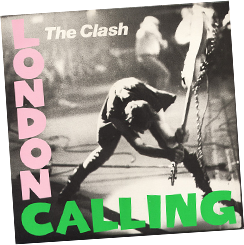This month we asked Tim Carlton
to share two of his passions - music and his home borough of Islington...
From Richard Sadler's 17th century Musik House to today's Union Chapel Islington's vibrant music scene has always moved with the times.
By the late 17th century the ‚ÄėHighbury Barn' was already a place of music, dance and general entertainment and by the 1800's people flocked to the tavern which could accommodate up to 15,000 revellers a day.
Over the next century music halls became 'de rigeuer‚Äė, the most famous being¬†Collins' Music Hall, on Islington Green which opened in 1863. Over the next century it launched¬†many music hall careers including,¬†George Formby,¬†Tommy Trinder,¬†Gracie Fields,¬†and¬†Norman Wisdom and in its heyday it was an¬†1,800-seat theatre with 10 bars.¬†It was partially destroyed by fire in 1958 when it closed its doors . All that remains today is the entrance area which is now a Waterstone's bookstore.
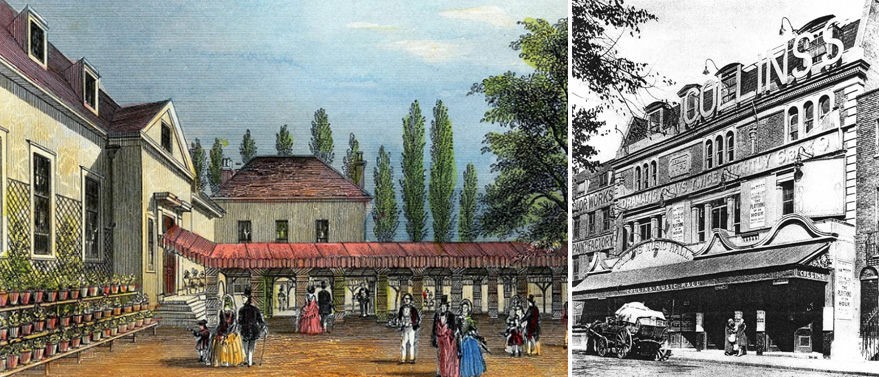
left; The Highbury Barn, c1800, right; Collins' Music Hall, Islington Green, c1900
In 1930 the Finsbury Park Astoria opened its doors and at the time was one of the world's largest venues.  Doubling as a cinema and concert venue it hosted many of the period's big acts. But with the advent of Rock'n'Roll things really began to take off and throughout the fifties and sixties the Finsbury Park Astoria become one of the premier music venues in the capital. Gene Vincent,The Beatles, the Rolling Stones and the Beach Boys all played here and it was at the Astoria that Jimi Hendrix famously burnt his Fender Stratocaster on stage for the first time.

left; The Astoria, Finsbury Park c1936, centre; The Beatles on stage for their first Astoria concert 1963, right; Jimi Hendrix onstage in March 1963 minutes before famously setting alight his Fender Stratocaster.
In 1971 the re-named ‚ÄėRainbow Theatre' gained legendary status, with all the major bands of the period performing, recording and¬†filming¬†their concerts there. The Who, David Bowie, Bob Marley, Pink Floyd and The Clash all appeared at the venue. The Rainbow held its last concert on 24th December 1984, performed by Elvis Costello and the Attractions and marked the 50th Anniversary of the iconic venue. It is now the¬†Universal Church of the Kingdom of God¬†- you could say the complete opposite to some of the ‚ÄėRock Gods' who strutted the Rainbow stage!
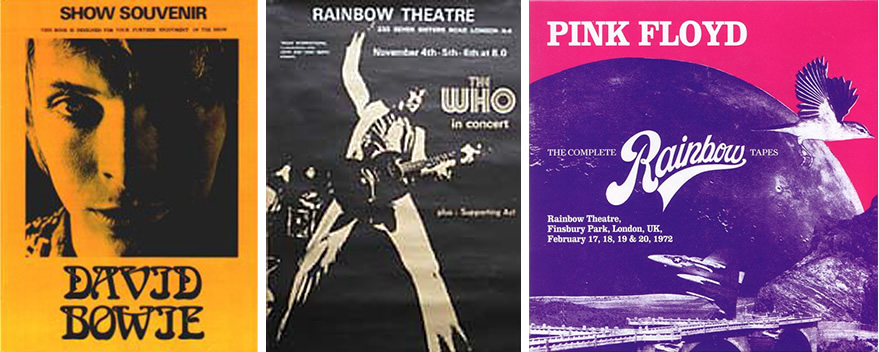
left; Souvenir programme from Bowie's Ziggy Stardust tour, August ‚Äė72, centre; The Who played three nights in 1971, right; Cover of Pink Floyd's Rainbow Tapes recorded over four nights of their 1972 performances, far right; The Wailers poster from their six-night 1977 concerts.
From the early 70's the borough became the centre of a throbbing Pub Rock scene, with pubs such as the George Robey in Finsbury Park, the Pegasus in Green Lanes and in nearby Camden, Dingwalls and the Dublin Castle.  These pubs all opened their doors to a crop of new and alternative Rock'n'Roll bands, but at the heart of this new scene was The Hope & Anchor, on Upper Street reaching legendary status with all the main bands from the scene performing here on a regular basis including Dr Feelgood, Eddie and the Hot Rods, Kilburn and the High Roads (later to become Ian Dury and Blockheads) and Joe Strummer's 101ers.
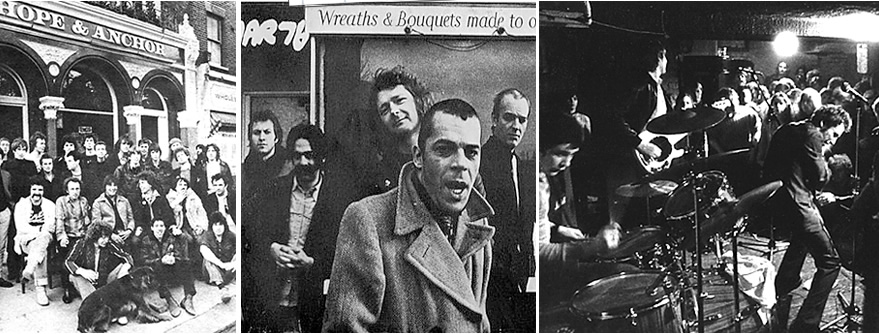
left; The Hope & Anchor's regular performers, centre; Kilburn and the High Roads, with soon to be famous frontman Ian Dury,1976, right; Dr Feelgood performing live on stage.
The Pub Rock scene laid the foundations for the onrush of Punk and¬†many¬†of the upcoming Punk bands had a ready-made network of pub venues. Newly formed bands such as the Damned, X-Ray Specs, the Clash, the Jam, Joy Division,¬†the Police and even¬†U2¬†(billed as ‚ÄėU2s'at the time) all played here and most went on to become major acts of the scene. Unfortunately the Council revoked the Hope‚Äės music¬†licence in the 80's and since then the venue has gone through various formats but has regained its¬†music license¬†and now puts on a mix of theatre and live performances.
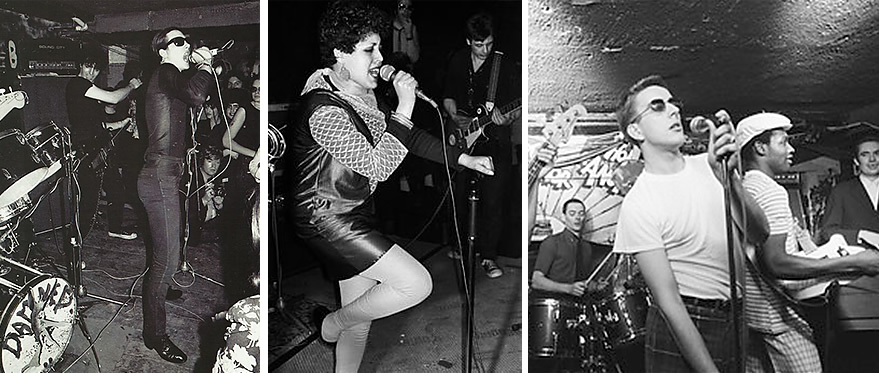
left; The Damned performing in 1976 centre; Polysterene of X-Ray Specs onstage in 1977 right; The Specials performing in 1980, below right ; Advert showing Joy Division's debut London gig on 27th December 1978, with an entrance fee of 60p!
Today the borough still has a vibrant music scene with a good mix of musical styles and venues including The Garage at Highbury Corner, the Union Chapel on Upper St, the Assembly Halls also on Upper St and the 02 Academy, Angel.  There is also a good selection of smaller pub-type venues such as the Lexington on Pentonville Rd, the Old Queen's Head, Essex Rd and of course, the Hope & Anchor.
While the borough has witnessed some historic and memorable performances over the years it has also been the birthplace of some of the most memorable recordings. In the summer of 1962, perhaps one of the most interesting and innovative records to be released in the sixties was conceived, produced and recorded by Joe Meek from his bedroom studio at 304 Holloway Road.  The site of this legendary recording is marked with a blue heritage plaque and Joe Meek's meteoric career was celebrated in the 2008 film Telstar: The Joe Meek story. 
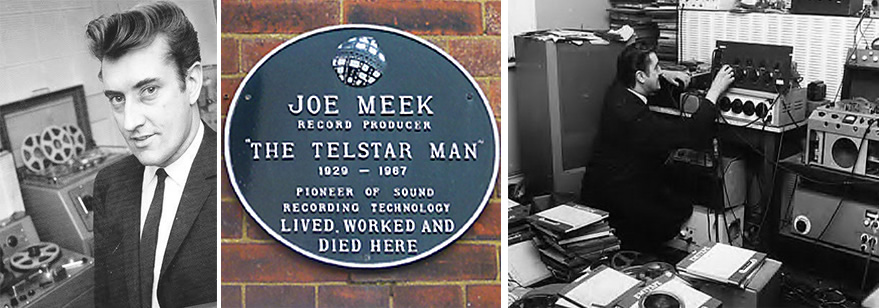
left; Joe Meek in 1961, centre; The blue plaque outside 304 Holloway Road, right; Meek working in his studio, right below; Record cover of Telstar, by the Tornados, released in August 1962 to celebrate the July launch of Nasa's Telstar satellite.
Telstar performed by the Tornados was released in August 1962, becoming a No.1 hit on both sides of the Atlantic and selling over 5 million copies worldwide. LA had Phil Spector but Islington had Joe Meek! 
His eccentric musical production techniques created a unique sound and over the coming years he created further hits such as Johnny Remember Me by John Leyton and the Honeycombs' and Have I the Right? in 1964. Unfortunately Meek, burdened by depression and paranoia. He even accused Phil Spector of ripping him off following a telephone conversation with the legendary US producer.
Meek‚Äės - at the time frowned upon - homosexuality and fascination with communicating with the dead sent him further into depression and his bouts of rage increased¬†to such levels that in February 1967 while having a minor argument with his landlady he shot and killed her and then took his own life, a¬†tragic end to one of Britain's most innovative record producers.
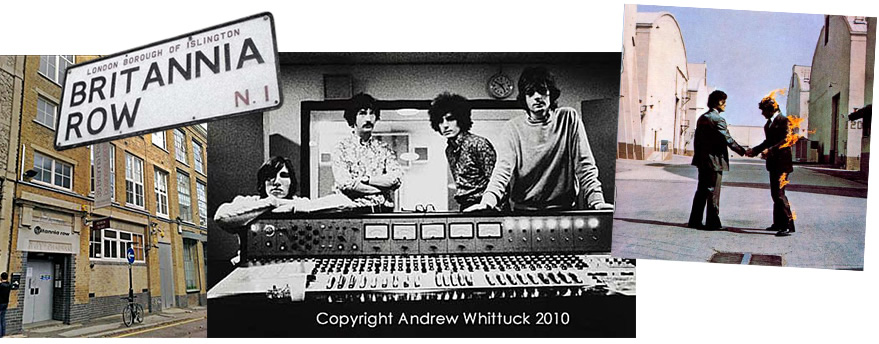
left; Brittania Row, as it looks today, centre; Pink Floyd pictured at their Brittania Row recording desk, right; Covers of the bands Wish You Were Here and The Wall albums recorded and produced at Brittania Row.
Telstar performed by the Tornados was released in August 1962, becoming a No.1 hit on both sides of the Atlantic and selling over 5 million copies worldwide. LA had Phil Spector but Islington had Joe Meek! 
His eccentric musical production techniques created a unique sound and over the coming years he created further hits such as Johnny Remember Me by John Leyton and the Honeycombs' and Have I the Right? in 1964. Unfortunately Meek, burdened by depression and paranoia. He even accused Phil Spector of ripping him off following a telephone conversation with the legendary US producer.
Meek‚Äės - at the time frowned upon - homosexuality and fascination with communicating with the dead sent him further into depression and his bouts of rage increased¬†to such levels that in February 1967 while having a minor argument with his landlady he shot and killed her and then took his own life, a¬†tragic end to one of Britain's most innovative record producers.
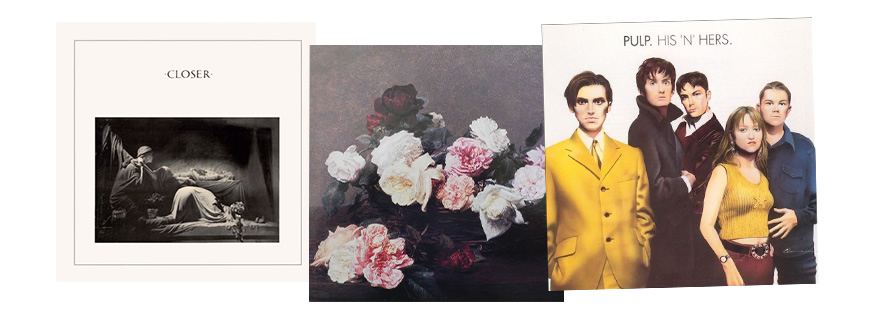
left; Joy Divisions' Closer their defining album, recorded in 1980, centre; New Order's Power, Coruption and Lies from 1983, right; Pulp's highly acclaimed His ‚ÄėN' Hers, recorded in 1984
The band sold the studio in the early 90's. But in the 1980's the studio became a great favourite for many of the decades most innovative bands including Kate Bush, Bjork, Joy Division and later as New Order who worked with producer Martin Hannett one of the decades great producers and last but not least Pulp. Sadly the studio closed it's doors in 2015 and was converted into two flats!

left; Wessex Studios housed in an inoffensive church hall built in 1881, centre; The Sex Pistols' Johnny Rotten recording Never Mind the Bollocks, 1976/77, right; The Clash recorded their seminal album London Calling in August 1979 far right; Queen in the studio recording We Will Rock You, 1977
Similarly, Wessex Studios situated in a church hall which nestles behind St Augustines Church in Highbury New Park N5, also became a world famous recording studio. Converted in 1960's and bought by the Beatles in 1965 - where the fifth Beatle, George Martin who incidentally was born in nearby Drayton Park produced many recordings here.
The list of acts who have recorded here is endless - David Bowie, the Rolling Stones, Stone Roses, King Crimson, the Clash, Talk Talk, Motorhead. Probably the most notable recordings here have been the Pistols' Never Mind the Bollocks, the Clash's London Calling' and Queen's We Will Rock You. Again, unfortunately the studios switched of its mic(s) in 2003 and it is now a residential development.
Islington still has a vibrant music scene, so get your gig guides out and go see - you won't be disappointed!
Tim Carlton
